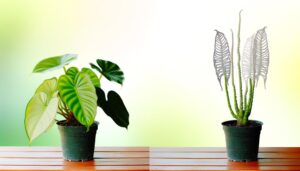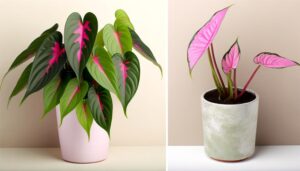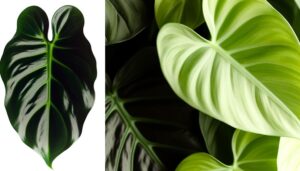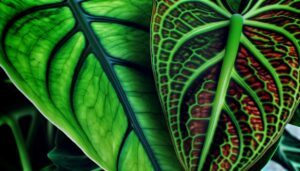Philodendron Micans Vs Scandens: A Detailed Comparison!
Philodendron micans and Philodendron scandens, while both epiphytic and popular in indoor gardening, display unique differences. Philodendron micans features velvety, heart-shaped leaves with an iridescent sheen and a bronzy-green hue, growing up to 10 cm long.
In contrast, Philodendron scandens has smooth, glossy, dark green leaves of a similar size. Micans exhibits slower, more climbing growth, while scandens grows rapidly, adapting to climbing or trailing.
Both require bright, indirect light, high humidity, and well-draining soil. Monthly fertilization enhances growth.
Micans is ideal for hanging baskets, whereas scandens suits vertical gardens. For further intriguing distinctions, continue exploring.
Comparison of Philodendron Micans and Philodendron Scandens
| Feature | Philodendron Micans | Philodendron Scandens |
|---|---|---|
| Scientific Name | Philodendron hederaceum ‘Micans’ | Philodendron hederaceum ‘Scandens’ |
| Common Name | Velvet Leaf Philodendron | Heartleaf Philodendron |
| Leaf Shape | Heart-shaped | Heart-shaped |
| Leaf Texture | Velvety, soft | Smooth, glossy |
| Leaf Color | Dark green with bronze undertones | Dark green |
| Growth Habit | Climbing or trailing vine | Climbing or trailing vine |
| Mature Size | Up to 3-6 feet indoors | Up to 4-6 feet indoors |
| Light Needs | Bright, indirect light | Bright, indirect light |
| Watering | Keep soil moist but not waterlogged | Keep soil moist but not waterlogged |
| Temperature | Prefers 65-80°F (18-27°C) | Prefers 65-80°F (18-27°C) |
| Humidity | Moderate to high (above 50%) | Moderate to high (above 50%) |
| Soil Type | Well-draining, rich potting mix | Well-draining, rich potting mix |
| Propagation | Stem cuttings | Stem cuttings |
| Toxicity | Toxic to pets and humans | Toxic to pets and humans |
| Special Care | Pruning to control size, regular fertilizing | Pruning to control size, regular fertilizing |
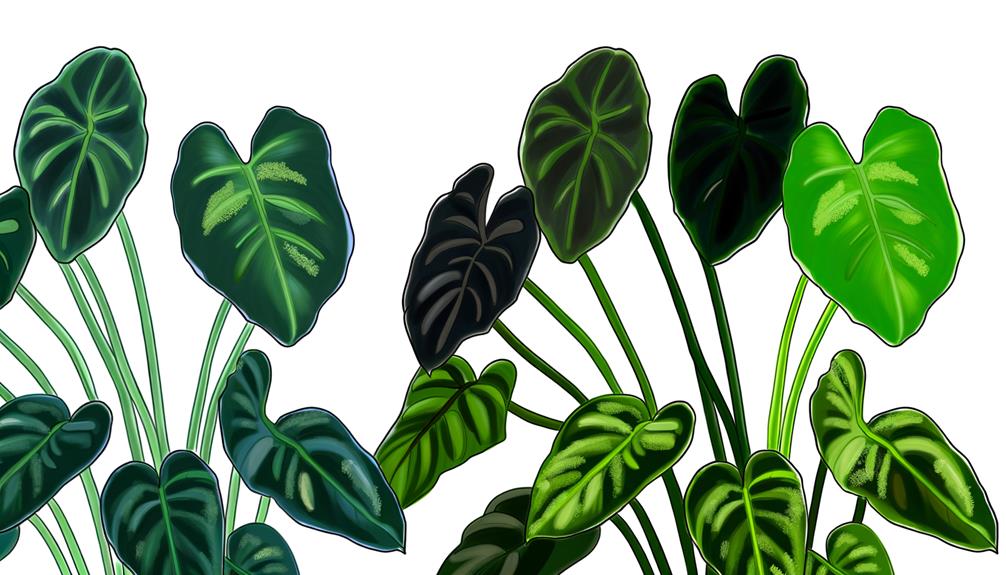
Foliage Comparison
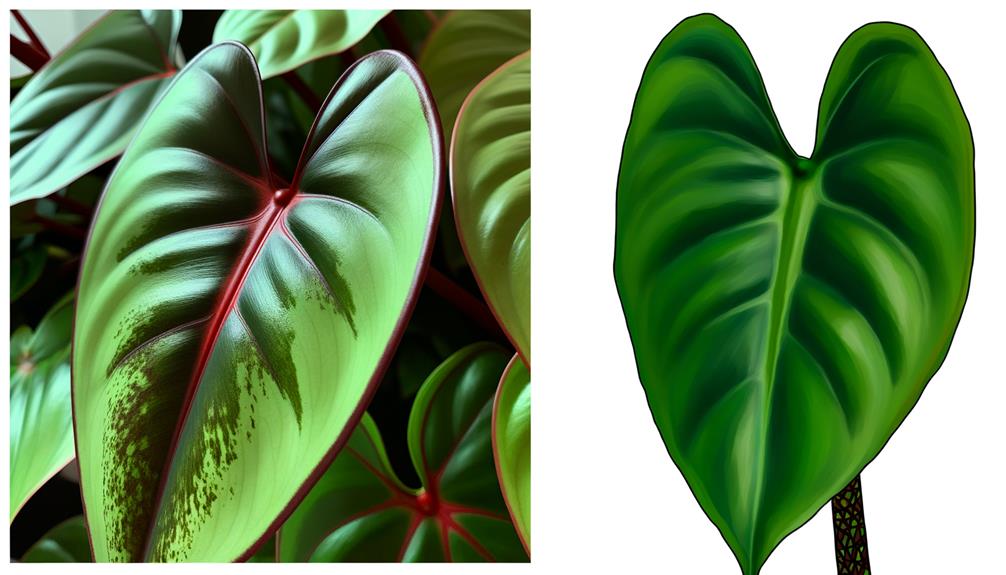
In comparing the foliage of Philodendron micans and Philodendron scandens, the former exhibits velvety, heart-shaped leaves with a distinct, iridescent sheen, while the latter features smooth, glossy leaves that are also heart-shaped but lack the velvety texture.
Philodendron micans, classified under the Araceae family, presents leaves that are typically 5-10 cm long and display a unique bronzy-green hue, which can appear almost luminous under indirect light.
Philodendron scandens, also an Araceae member, produces leaves of similar size but with a more consistent, darker green coloration.
For best care, both species require well-draining soil, moderate watering, and placement in bright, indirect light to maintain their foliage’s aesthetic and structural integrity.
Growth Habits
Understanding the growth habits of Philodendron micans and Philodendron scandens is essential for ideal cultivation and maintenance. Both species exhibit vining behavior, making them excellent choices for hanging baskets or trellises.
Philodendron micans, a member of the Araceae family, typically displays a more trailing growth pattern with velvety leaves, whereas Philodendron scandens, also known as the heartleaf philodendron, tends to grow more vigorously with larger, glossy leaves.
Key growth characteristics include:
- Philodendron micans: Slower growth rate, prefers climbing but can trail, smaller internodal spaces.
- Philodendron scandens: Rapid growth, adaptable to climbing or trailing, longer internodal spaces.
- Both species: Epiphytic nature, capable of aerial root development, adaptable to various light conditions.
Understanding these habits ensures the best plant health and aesthetics.
Care Requirements
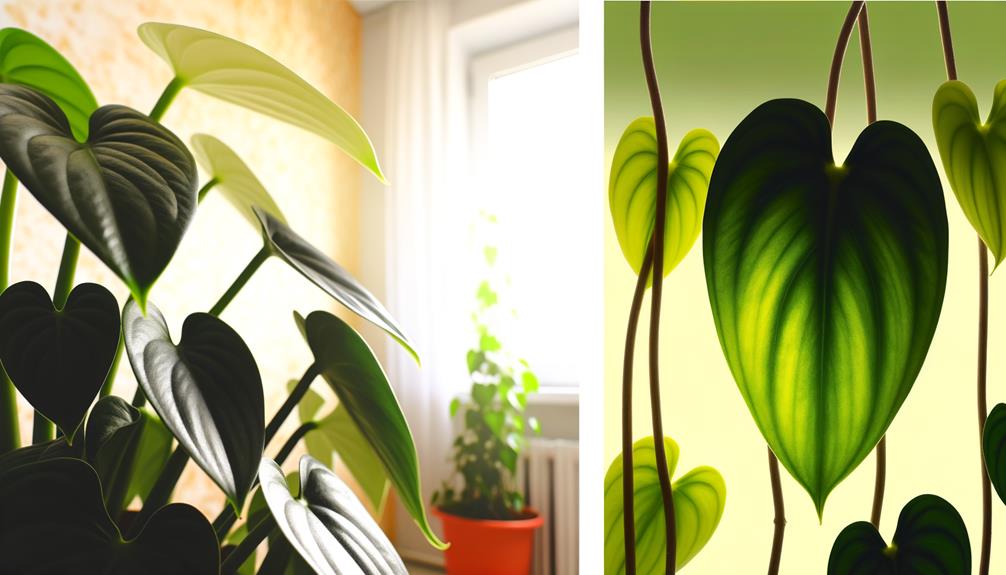
Best care for Philodendron micans and Philodendron scandens involves regulating light exposure, humidity levels, and soil composition to mimic their native tropical environments. These epiphytic species thrive under indirect light and require high humidity levels, preferably above 60%.
A well-draining aroid mix, consisting of peat, perlite, and orchid bark, is optimal for root aeration and moisture retention. Watering should be consistent yet moderate, allowing the top inch of soil to dry out between waterings. Fertilize monthly during the growing season with a balanced, water-soluble fertilizer to support vigorous growth.
| Care Aspect | Philodendron micans | Philodendron scandens |
|---|---|---|
| Light | Indirect, bright | Indirect, bright |
| Humidity | High (60%+) | High (60%+) |
| Soil | Well-draining aroid mix | Well-draining aroid mix |
| Watering | Moderate, let soil dry | Moderate, let soil dry |
| Fertilization | Monthly during growth phase | Monthly during growth phase |
Ideal Environments
Why is it important to replicate their natural habitats when cultivating Philodendron micans and Philodendron scandens in domestic settings?
Mimicking their native environments is crucial for these species to thrive. This involves regulating light, humidity, and temperature to approximate their original conditions in Central and South America.
- Light: Both species prefer bright, indirect sunlight. Direct exposure can cause leaf scorching, while inadequate light leads to leggy growth.
- Humidity: Optimum growth occurs in high humidity levels, ideally between 60-80%, requiring regular misting or the use of a humidifier.
- Temperature: Maintain ambient temperatures between 65-80°F (18-27°C) to promote strong growth, avoiding temperature fluctuations that may stress the plants.
Following these guidelines ensures that Philodendron micans and Philodendron scandens flourish in indoor environments.
Popular Uses
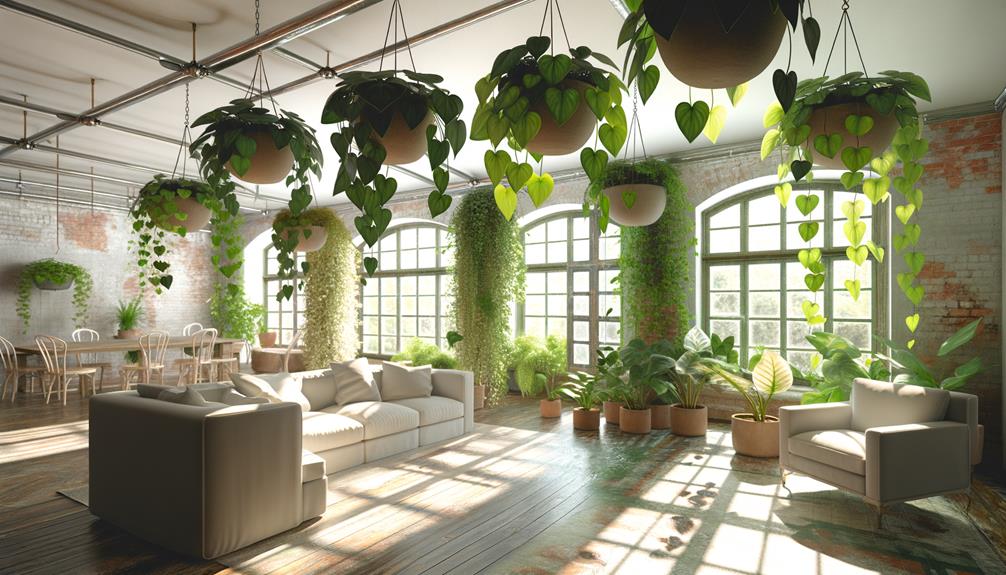
Incorporating Philodendron micans and Philodendron scandens into interior landscapes enhances aesthetic appeal while contributing to improved air quality.
Philodendron micans, with its velvety, heart-shaped leaves, is often utilized in hanging baskets or as a trailing plant on shelves, creating a visually striking display.
Philodendron scandens, also known as the Heartleaf Philodendron, is favored for its vigorous growth and adaptability, making it ideal for vertical gardens and living walls.
Both species are effective in phytoremediation, absorbing volatile organic compounds (VOCs) such as formaldehyde and benzene from indoor environments.
Their epiphytic nature allows them to thrive in constrained spaces, requiring minimal soil and maintenance, hence making them perfect candidates for modern, space-efficient interior designs.
Philodendron Scandens F Micans
The Philodendron scandens ‘Micans’, often simply known as Philodendron ‘Micans’, is a variety of the Heartleaf Philodendron that is cherished for its unique and striking foliage. This plant is a must-have for indoor plant enthusiasts due to its aesthetic appeal and easy-care nature.
Here are the distinctive characteristics and care requirements of Philodendron ‘Micans’:
Leaf Characteristics
- Color: The leaves of ‘Micans’ are what really set it apart. They exhibit a velvety texture with a color palette that ranges from deep greens to rich purples and sometimes almost a rust-like hue, especially under brighter light conditions. The underside of the leaves typically has a purplish tone.
- Shape and Texture: The leaves are heart-shaped, similar to the classic Philodendron scandens, but smaller and with a distinctive velvety texture that catches the light beautifully.
Growth Habit
- Vining Nature: Philodendron ‘Micans’ is a vining plant, which makes it perfect for hanging baskets or allowing to climb on moss poles or other supports. Its trailing habit can create a stunning visual display as it grows.
- Growth Rate: It grows at a moderate pace, which makes it manageable in an indoor setting.
Care Requirements
- Light: Prefers bright, indirect light but can tolerate lower light conditions, which may lead to less vibrant leaf color. Direct sunlight should be avoided as it can scorch the velvety leaves.
- Soil: Thrives in well-draining, nutrient-rich potting soil. A mixture suitable for aroids works well, ideally with some added perlite or orchid bark for extra drainage.
- Water: It’s important to water the plant when the top inch of soil dries out, keeping the soil consistently moist but not soggy. Overwatering can lead to root rot.
- Humidity: While ‘Micans’ can tolerate average home humidity, it thrives in higher humidity conditions. Regular misting, a pebble tray, or a room humidifier can help meet its preference for moisture.
Overall Appeal
Philodendron ‘Micans’ is favored not only for its beautiful, velvety leaves but also for its adaptability and ease of care. It’s a versatile plant that can be styled in various ways, either as a hanging plant or trained to climb, providing a lush, tropical feel to any interior space. It’s particularly popular among those who appreciate the tactile and visual texture of plants.
Conclusion
In summation, while Philodendron micans and Philodendron scandens share similarities in their botanical taxonomy, distinct differences exist in their foliage, growth habits, and care requirements.
Philodendron micans boasts velvety leaves, whereas Philodendron scandens presents glossy foliage. Both species thrive in humid, indirect light environments but require tailored care regimens.
As the old adage goes, ‘Variety is the spice of life,’ underscoring the diverse applications and aesthetic contributions each philodendron can offer to botanical collections and interior landscaping.



